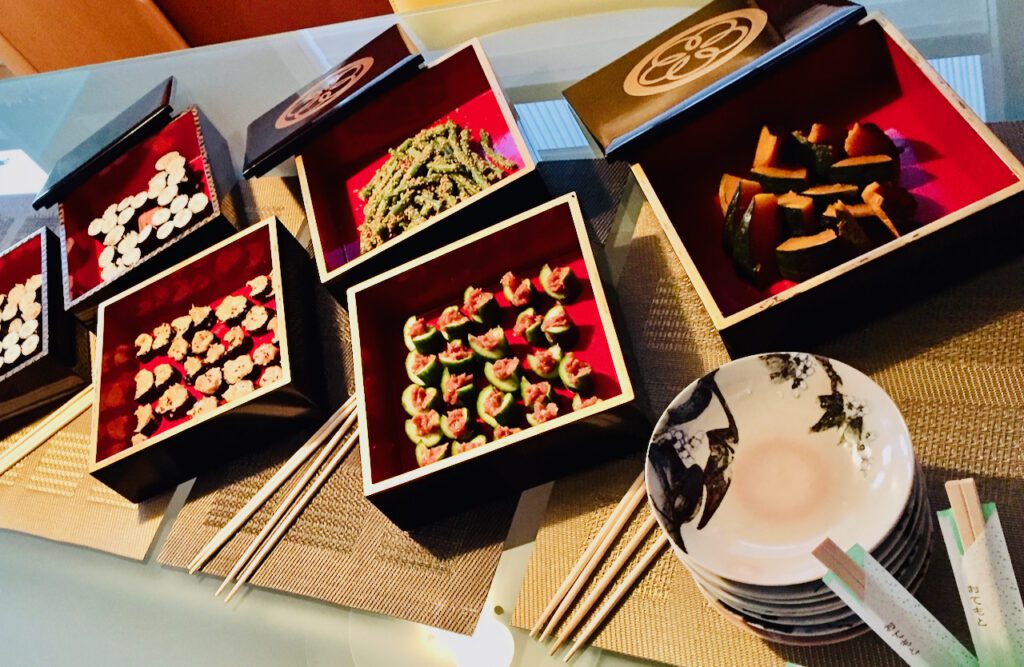What is Urushi?
My urushi lacquered jubako boxes: Photo by Author Akemi Sagawa
Urushi lacquerware was all around me in my daily life in Japan. I loved urushi lacquerware then and I still love it today. I often use wooden jubako boxes and plates coated in Urushi lacquer to decorate food for parties.

Jubako with party food: Photo by Author Akemi Sagawa

Appetizer on Urushi lacquered wooden plate: Photo by Author Akemi Sagawa
What is Urushi
Urushi (漆) is Japanese lacquer, a varnish obtained from the urushi tree (botanical name: toxicodendron vernicifluum). For so long Japanese people have been using items coated with urushi. Some items show a natural wood grain through a translucent urushi coating. Some items have a shiny black or red finish. Some have intricate designs decorated with gold and silver. Urushi lacquer is used in a variety of ways in Japan.
Japanese kanji characters are ideogramic. The names of trees have a kanji character that means tree “木” on the left side. For example, 桜cherry, 松pine, 楓maple, 梅plum, 柳willow.
The kanji for urushi 漆 tree, however, has the character for water on the left. It is the only exception among trees. The character indicates that it is the sap of the urushi tree that is most important.
Some people might say that anything civilized in Japan originally came from China. But the facts tell a different story when it comes to urushi. The oldest urushi object in the world was discovered at Kakinoshima “B” Excavation Site in Hokkaido, Japan. It is a decorative item woven with red thread, coated with urushi. The object is over 9,000 years old, about 2,000 years older than the oldest urushi object found in China.
It is widely thought that the urushi tree originated in China and came to Japan. However, the urushi branch discovered in Torihama Shell-Mound in Fukui Prefecture is about 12,600 years old, making it the world’s oldest record of an urushi tree. We can’t eliminate the possibility that urushi trees didn’t come from China but originated in Japan.
Benefits of Urushi
Urushi sap, known as Urushiol, causes an allergic reaction in many people. Only after urushi has hardened completely does the danger of a skin rash disappear. How and why did the people in ancient times start using urushi in their lives? There are several reasons.
Durability: Once hardened, urushi is such a durable coating material. The fact that we can still trace a 9,000-year-old object is powerful evidence. The woven decorative item found in Kakinoshima survived from decomposition because the threads were protected by urushi. Research shows that urushi is highly resistant to both acidity and alkali.
Adhesiveness: Urushi is a powerful adhesive. Have you heard of kintsugi? It’s the Japanese art of repairing broken pottery by mending the areas of breakage with urushi dusted or mixed with gold, silver, or platinum. Neither gold nor silver has the ability to glue together broken pieces. Urushi is what glues together the broken parts.
Antibacteria: It is scientifically proven that hardened urushi is antibacterial. Place e.coli bacteria on a surface coated with urushi, and the bacteria eventually disappear. In the subtropical and temperate climates of Japan, when no easy refrigeration was available, food containers coated with antibacterial urushi were valuable.
Its durability, its adhesiveness, and its antibacterial nature…. I’m still awed by the intelligence of ancient human beings for having discovered the wonderful utility of this rather poisonous sap. And I’m awed by the creativity of human beings in making so many beautiful things out of this useful material.
The Future of Urushi
Sadly, both consumption and production of Urushi lacquerware is decreasing in Japan. Many craftspeople are getting old, and they are having a hard time finding young people to take over their centuries-old skills.
Why is this trend a problem? Why does it matter to preserve such old crafts? What can we do to avoid such crafts from extinction?
Those questions occupy my thoughts. I’m hoping Medium is the right platform to share my thoughts.
